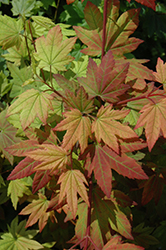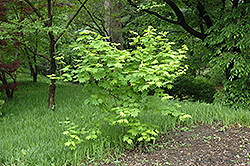Height: 15 feet
Spread: 20 feet
Sunlight:
![]()
![]()
Hardiness Zone: 5
Description:
This west coast native makes an exceptional landscape tree for smaller yards and gardens; brilliant fall color; attracts nesting birds; best with some shelter, needs moist soil, water more if grown in full sun
Ornamental Features
Vine Maple has attractive light green deciduous foliage on a plant with an oval habit of growth. The lobed leaves are highly ornamental and turn outstanding shades of orange and in the fall. It has corymbs of chartreuse flowers with red calyces in mid spring. It produces red samaras in early fall.
Landscape Attributes
Vine Maple is a multi-stemmed deciduous shrub with a shapely oval form. Its average texture blends into the landscape, but can be balanced by one or two finer or coarser trees or shrubs for an effective composition.
This is a relatively low maintenance shrub, and should only be pruned in summer after the leaves have fully developed, as it may 'bleed' sap if pruned in late winter or early spring. It has no significant negative characteristics.
Vine Maple is recommended for the following landscape applications;
- Accent
- Mass Planting
- Hedges/Screening
- General Garden Use
Planting & Growing
Vine Maple will grow to be about 15 feet tall at maturity, with a spread of 20 feet. It has a low canopy with a typical clearance of 2 feet from the ground, and is suitable for planting under power lines. It grows at a medium rate, and under ideal conditions can be expected to live for 60 years or more.
This shrub does best in partial shade to shade. It requires an evenly moist well-drained soil for optimal growth, but will die in standing water. It is not particular as to soil pH, but grows best in rich soils. It is quite intolerant of urban pollution, therefore inner city or urban streetside plantings are best avoided, and will benefit from being planted in a relatively sheltered location. Consider applying a thick mulch around the root zone over the growing season to conserve soil moisture. This species is native to parts of North America.

